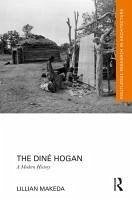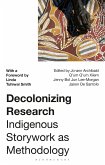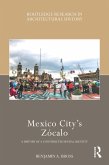- Gebundenes Buch
- Merkliste
- Auf die Merkliste
- Bewerten Bewerten
- Teilen
- Produkt teilen
- Produkterinnerung
- Produkterinnerung
Over the course of their history, the Navajo have constructed many types of architecture, but during the 20th century, one building emerged to become a powerful and inspiring symbol of tribal culture. This book describes the rise of the octagonal stacked-log hogan as the most important architectural form among the Diné.
Andere Kunden interessierten sich auch für
![Religion, Heritage and the Sustainable City Religion, Heritage and the Sustainable City]() Yamini NarayananReligion, Heritage and the Sustainable City209,99 €
Yamini NarayananReligion, Heritage and the Sustainable City209,99 €![Politics and Aesthetics in Contemporary Native American Literature Politics and Aesthetics in Contemporary Native American Literature]() Matthew HermanPolitics and Aesthetics in Contemporary Native American Literature195,99 €
Matthew HermanPolitics and Aesthetics in Contemporary Native American Literature195,99 €![Decolonizing Research Decolonizing Research]() Decolonizing Research22,99 €
Decolonizing Research22,99 €![Bodies and Lives in Ancient America Bodies and Lives in Ancient America]() Debra MartinBodies and Lives in Ancient America197,99 €
Debra MartinBodies and Lives in Ancient America197,99 €![Mexico City's Zócalo Mexico City's Zócalo]() Benjamin A BrossMexico City's Zócalo197,99 €
Benjamin A BrossMexico City's Zócalo197,99 €![Fashioning Vienna Fashioning Vienna]() Janet StewartFashioning Vienna137,99 €
Janet StewartFashioning Vienna137,99 €![Rebuilding Urban Complexity Rebuilding Urban Complexity]() Francesca FroyRebuilding Urban Complexity198,99 €
Francesca FroyRebuilding Urban Complexity198,99 €-
-
-
Over the course of their history, the Navajo have constructed many types of architecture, but during the 20th century, one building emerged to become a powerful and inspiring symbol of tribal culture. This book describes the rise of the octagonal stacked-log hogan as the most important architectural form among the Diné.
Hinweis: Dieser Artikel kann nur an eine deutsche Lieferadresse ausgeliefert werden.
Hinweis: Dieser Artikel kann nur an eine deutsche Lieferadresse ausgeliefert werden.
Produktdetails
- Produktdetails
- Verlag: Taylor & Francis
- Seitenzahl: 250
- Erscheinungstermin: 28. Juni 2024
- Englisch
- Abmessung: 239mm x 155mm x 18mm
- Gewicht: 640g
- ISBN-13: 9781032552576
- ISBN-10: 1032552573
- Artikelnr.: 70150587
- Herstellerkennzeichnung
- Libri GmbH
- Europaallee 1
- 36244 Bad Hersfeld
- gpsr@libri.de
- Verlag: Taylor & Francis
- Seitenzahl: 250
- Erscheinungstermin: 28. Juni 2024
- Englisch
- Abmessung: 239mm x 155mm x 18mm
- Gewicht: 640g
- ISBN-13: 9781032552576
- ISBN-10: 1032552573
- Artikelnr.: 70150587
- Herstellerkennzeichnung
- Libri GmbH
- Europaallee 1
- 36244 Bad Hersfeld
- gpsr@libri.de
Lillian Makeda writes about the architecture and interior design of the American Southwest from her home in western New Mexico. Her work has appeared in The Architectural Review, Buildings and Landscapes, Journal of the Southwest, Society of Architectural Historians Archipedia, and Kiva: Journal of Southwestern Anthropology and History. She recently completed a Getty/ACLS postdoctoral fellowship in the history of art and is presently working on her next book, which will focus on the Santa Fe style of interior design.
Preface
Acknowledgments
Introduction: What Is a Hogan?
Chapter 1: Anthropology Villages and the Diné Hogan, 1890-1950
The 1893 World's Columbian Exposition in Chicago
The 1902 and 1911 Alvarado Indian Villages
The 1904 Louisiana Purchase International Exposition in St. Louis
The 1905 Indian Village at the Grand Canyon
The 1906 Indian Crafts Exhibition at Eastlake Park in Los Angeles
The 1909 United States Land and Irrigation Exposition in Chicago
The 1915-1916 Panama-California Exposition in San Diego
The 1915 Panama-Pacific Exposition in San Francisco
Mesa Verde National Park, 1925-1942
The 1933-1934 Century of Progress Exposition in Chicago
The 1936 Texas Centennial Exposition in Dallas
The 1948-1949 Chicago Railroad Fair
Epilogue: The Discover Navajo Pavilion at the 2002 Winter Olympics in Salt
Lake City
Chapter 2: "Improving" the Hogan
Governmental Efforts to Encourage Permanent Homes, 1868-1900
Model Homes for Native Americans: The Omaha Cottages at Hampton Institute
Native American Architecture and the Indian Boarding Schools
The Sanitation Issue
Louisa Wetherill's "Big Hogan"
Reassessing the Relationship Between the Hogan and Disease
Model Hogans at Schools on the Navajo Reservation, 1922-1931
The Federal Government and Native American Architecture, 1925-1932
Model Hogans and the Presbyterian Mission to the Navajo
Chapter 3: Route 66 and Diné Architecture
Interpreting Route 66 Hogans
Navajo Rug Stands
Trading Posts and the Diné Hogan
Navajo-Inflected Architecture Along Route 66
Route 66 and the Jacobs Family
New Uses for the Diné Hogan
The Stacked-Log Hogan Becomes a Roadside Icon
Chapter 4: The Indian New Deal
John Collier
Mayers, Murray & Phillip
The Soil Erosion Control Experiment Station in Mexican Springs
Practice Hogans on the Navajo Reservation
Hogans for Diné Nurse's Aids
Chapter 5: Jacob Morgan and John Collier: Ideology and the Navajo Hogan
Schools for the Diné Before 1933
Native American Architecture for Native American Day Schools
Jacob C. Morgan
A Political Controversy
John Collier and Diné Architecture, 1937-1945
Chapter 6: The Stacked-Log Hogan Becomes an Architectural Type
Model and Type
The Navajo House of Religion, 1929-1937
The Navajo Nation Council Chamber, 1934-1935
John Carl Warnecke's Projects for the Navajo Nation, 1958-1977
Education and Tribal Self-Determination: Rough Rock Demonstration School
and Navajo Community College
The Navajo Hogan and Public Architecture in the 1970s and 1980s
Studio Southwest: The Navajo Nation Museum and New Schools for the Diné
Leon Shirley: Public Housing for the Diné and a Senior Center for Twin
Lakes
Dyron Murphy: A Diversity of Hogan-Inspired Designs
Creating a Diné Sacred Place: The Senator John Pinto Library in Shiprock,
2009-2011
Conclusion: The Stacked-Log Hogan Becomes a Cultural Icon
Illustration Credits
Index
Acknowledgments
Introduction: What Is a Hogan?
Chapter 1: Anthropology Villages and the Diné Hogan, 1890-1950
The 1893 World's Columbian Exposition in Chicago
The 1902 and 1911 Alvarado Indian Villages
The 1904 Louisiana Purchase International Exposition in St. Louis
The 1905 Indian Village at the Grand Canyon
The 1906 Indian Crafts Exhibition at Eastlake Park in Los Angeles
The 1909 United States Land and Irrigation Exposition in Chicago
The 1915-1916 Panama-California Exposition in San Diego
The 1915 Panama-Pacific Exposition in San Francisco
Mesa Verde National Park, 1925-1942
The 1933-1934 Century of Progress Exposition in Chicago
The 1936 Texas Centennial Exposition in Dallas
The 1948-1949 Chicago Railroad Fair
Epilogue: The Discover Navajo Pavilion at the 2002 Winter Olympics in Salt
Lake City
Chapter 2: "Improving" the Hogan
Governmental Efforts to Encourage Permanent Homes, 1868-1900
Model Homes for Native Americans: The Omaha Cottages at Hampton Institute
Native American Architecture and the Indian Boarding Schools
The Sanitation Issue
Louisa Wetherill's "Big Hogan"
Reassessing the Relationship Between the Hogan and Disease
Model Hogans at Schools on the Navajo Reservation, 1922-1931
The Federal Government and Native American Architecture, 1925-1932
Model Hogans and the Presbyterian Mission to the Navajo
Chapter 3: Route 66 and Diné Architecture
Interpreting Route 66 Hogans
Navajo Rug Stands
Trading Posts and the Diné Hogan
Navajo-Inflected Architecture Along Route 66
Route 66 and the Jacobs Family
New Uses for the Diné Hogan
The Stacked-Log Hogan Becomes a Roadside Icon
Chapter 4: The Indian New Deal
John Collier
Mayers, Murray & Phillip
The Soil Erosion Control Experiment Station in Mexican Springs
Practice Hogans on the Navajo Reservation
Hogans for Diné Nurse's Aids
Chapter 5: Jacob Morgan and John Collier: Ideology and the Navajo Hogan
Schools for the Diné Before 1933
Native American Architecture for Native American Day Schools
Jacob C. Morgan
A Political Controversy
John Collier and Diné Architecture, 1937-1945
Chapter 6: The Stacked-Log Hogan Becomes an Architectural Type
Model and Type
The Navajo House of Religion, 1929-1937
The Navajo Nation Council Chamber, 1934-1935
John Carl Warnecke's Projects for the Navajo Nation, 1958-1977
Education and Tribal Self-Determination: Rough Rock Demonstration School
and Navajo Community College
The Navajo Hogan and Public Architecture in the 1970s and 1980s
Studio Southwest: The Navajo Nation Museum and New Schools for the Diné
Leon Shirley: Public Housing for the Diné and a Senior Center for Twin
Lakes
Dyron Murphy: A Diversity of Hogan-Inspired Designs
Creating a Diné Sacred Place: The Senator John Pinto Library in Shiprock,
2009-2011
Conclusion: The Stacked-Log Hogan Becomes a Cultural Icon
Illustration Credits
Index
Preface
Acknowledgments
Introduction: What Is a Hogan?
Chapter 1: Anthropology Villages and the Diné Hogan, 1890-1950
The 1893 World's Columbian Exposition in Chicago
The 1902 and 1911 Alvarado Indian Villages
The 1904 Louisiana Purchase International Exposition in St. Louis
The 1905 Indian Village at the Grand Canyon
The 1906 Indian Crafts Exhibition at Eastlake Park in Los Angeles
The 1909 United States Land and Irrigation Exposition in Chicago
The 1915-1916 Panama-California Exposition in San Diego
The 1915 Panama-Pacific Exposition in San Francisco
Mesa Verde National Park, 1925-1942
The 1933-1934 Century of Progress Exposition in Chicago
The 1936 Texas Centennial Exposition in Dallas
The 1948-1949 Chicago Railroad Fair
Epilogue: The Discover Navajo Pavilion at the 2002 Winter Olympics in Salt
Lake City
Chapter 2: "Improving" the Hogan
Governmental Efforts to Encourage Permanent Homes, 1868-1900
Model Homes for Native Americans: The Omaha Cottages at Hampton Institute
Native American Architecture and the Indian Boarding Schools
The Sanitation Issue
Louisa Wetherill's "Big Hogan"
Reassessing the Relationship Between the Hogan and Disease
Model Hogans at Schools on the Navajo Reservation, 1922-1931
The Federal Government and Native American Architecture, 1925-1932
Model Hogans and the Presbyterian Mission to the Navajo
Chapter 3: Route 66 and Diné Architecture
Interpreting Route 66 Hogans
Navajo Rug Stands
Trading Posts and the Diné Hogan
Navajo-Inflected Architecture Along Route 66
Route 66 and the Jacobs Family
New Uses for the Diné Hogan
The Stacked-Log Hogan Becomes a Roadside Icon
Chapter 4: The Indian New Deal
John Collier
Mayers, Murray & Phillip
The Soil Erosion Control Experiment Station in Mexican Springs
Practice Hogans on the Navajo Reservation
Hogans for Diné Nurse's Aids
Chapter 5: Jacob Morgan and John Collier: Ideology and the Navajo Hogan
Schools for the Diné Before 1933
Native American Architecture for Native American Day Schools
Jacob C. Morgan
A Political Controversy
John Collier and Diné Architecture, 1937-1945
Chapter 6: The Stacked-Log Hogan Becomes an Architectural Type
Model and Type
The Navajo House of Religion, 1929-1937
The Navajo Nation Council Chamber, 1934-1935
John Carl Warnecke's Projects for the Navajo Nation, 1958-1977
Education and Tribal Self-Determination: Rough Rock Demonstration School
and Navajo Community College
The Navajo Hogan and Public Architecture in the 1970s and 1980s
Studio Southwest: The Navajo Nation Museum and New Schools for the Diné
Leon Shirley: Public Housing for the Diné and a Senior Center for Twin
Lakes
Dyron Murphy: A Diversity of Hogan-Inspired Designs
Creating a Diné Sacred Place: The Senator John Pinto Library in Shiprock,
2009-2011
Conclusion: The Stacked-Log Hogan Becomes a Cultural Icon
Illustration Credits
Index
Acknowledgments
Introduction: What Is a Hogan?
Chapter 1: Anthropology Villages and the Diné Hogan, 1890-1950
The 1893 World's Columbian Exposition in Chicago
The 1902 and 1911 Alvarado Indian Villages
The 1904 Louisiana Purchase International Exposition in St. Louis
The 1905 Indian Village at the Grand Canyon
The 1906 Indian Crafts Exhibition at Eastlake Park in Los Angeles
The 1909 United States Land and Irrigation Exposition in Chicago
The 1915-1916 Panama-California Exposition in San Diego
The 1915 Panama-Pacific Exposition in San Francisco
Mesa Verde National Park, 1925-1942
The 1933-1934 Century of Progress Exposition in Chicago
The 1936 Texas Centennial Exposition in Dallas
The 1948-1949 Chicago Railroad Fair
Epilogue: The Discover Navajo Pavilion at the 2002 Winter Olympics in Salt
Lake City
Chapter 2: "Improving" the Hogan
Governmental Efforts to Encourage Permanent Homes, 1868-1900
Model Homes for Native Americans: The Omaha Cottages at Hampton Institute
Native American Architecture and the Indian Boarding Schools
The Sanitation Issue
Louisa Wetherill's "Big Hogan"
Reassessing the Relationship Between the Hogan and Disease
Model Hogans at Schools on the Navajo Reservation, 1922-1931
The Federal Government and Native American Architecture, 1925-1932
Model Hogans and the Presbyterian Mission to the Navajo
Chapter 3: Route 66 and Diné Architecture
Interpreting Route 66 Hogans
Navajo Rug Stands
Trading Posts and the Diné Hogan
Navajo-Inflected Architecture Along Route 66
Route 66 and the Jacobs Family
New Uses for the Diné Hogan
The Stacked-Log Hogan Becomes a Roadside Icon
Chapter 4: The Indian New Deal
John Collier
Mayers, Murray & Phillip
The Soil Erosion Control Experiment Station in Mexican Springs
Practice Hogans on the Navajo Reservation
Hogans for Diné Nurse's Aids
Chapter 5: Jacob Morgan and John Collier: Ideology and the Navajo Hogan
Schools for the Diné Before 1933
Native American Architecture for Native American Day Schools
Jacob C. Morgan
A Political Controversy
John Collier and Diné Architecture, 1937-1945
Chapter 6: The Stacked-Log Hogan Becomes an Architectural Type
Model and Type
The Navajo House of Religion, 1929-1937
The Navajo Nation Council Chamber, 1934-1935
John Carl Warnecke's Projects for the Navajo Nation, 1958-1977
Education and Tribal Self-Determination: Rough Rock Demonstration School
and Navajo Community College
The Navajo Hogan and Public Architecture in the 1970s and 1980s
Studio Southwest: The Navajo Nation Museum and New Schools for the Diné
Leon Shirley: Public Housing for the Diné and a Senior Center for Twin
Lakes
Dyron Murphy: A Diversity of Hogan-Inspired Designs
Creating a Diné Sacred Place: The Senator John Pinto Library in Shiprock,
2009-2011
Conclusion: The Stacked-Log Hogan Becomes a Cultural Icon
Illustration Credits
Index








